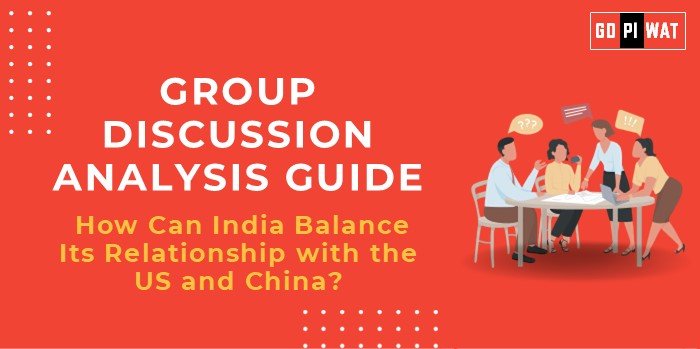📋 GD Analysis Guide: How Can India Balance Its Relationship with the US and China?
🌐 Introduction to the Topic
Opening Context: “India, as a rising global power, finds itself in a strategic triangle with the US and China—balancing diplomatic, economic, and defense ties with two of the world’s largest powers.”
Topic Background: The India-US relationship is underpinned by shared democratic values and robust trade, while India-China ties are marked by territorial disputes but critical economic interdependence. The ongoing power struggle between the US and China adds complexity to India’s balancing act.
📊 Quick Facts and Key Statistics
- 💰 US-India Trade (2023): $191 billion, making the US India’s largest trading partner.
- 📦 China-India Trade (2023): $125 billion, with China being India’s largest import source.
- 🛡️ Defense Partnerships: India participates in QUAD with the US but maintains distance from explicit anti-China blocs.
- ⚔️ Border Disputes: Over 3,440 km boundary dispute with China; Galwan clash in 2020 escalated tensions.
🔗 Stakeholders and Their Roles
- 🤝 Government of India: Balancing foreign policy, trade, and security.
- 🇺🇸 US Government: Seeks deeper military and economic ties with India as part of Indo-Pacific strategy.
- 🇨🇳 China’s Leadership: Focused on Belt and Road Initiative (BRI) expansion and securing its border claims.
- 🏢 Private Sector: Multinational companies influenced by market dynamics and supply chain dependencies.
🏆 Achievements and Challenges
✨ Achievements
- ⚖️ Strategic Autonomy: India’s multi-alignment policy (e.g., purchasing Russian oil, US defense tech).
- 📈 Economic Growth: Leveraging trade with both powers while attracting investments.
- 💻 Digital Collaboration: US-India tech partnerships; China’s smartphone dominance in India.
⚠️ Challenges
- ⚔️ Border Tensions: Persistent clashes at LAC.
- 📉 Trade Deficits: India’s $71 billion trade deficit with China (2023).
- 🤔 Strategic Dilemma: Pressure from the US to align against China versus economic reliance on Beijing.
🌍 Global Comparisons
- 🇻🇳 Vietnam: Balancing China for trade and the US for strategic alliances.
- 🇯🇵 Japan: Combines robust US defense ties with cautious economic engagement with China.
📚 Case Studies
- ⚔️ Galwan Clash (2020): Led to a shift in India’s approach to China, emphasizing decoupling.
- 💼 Indo-US Defense Deals: Major acquisitions like S-400 systems and drones underline balanced ties.
🎯 Structured Arguments for Discussion
- Supporting Stance: “India’s strategic autonomy allows it to benefit economically from both nations while securing its borders effectively.”
- Opposing Stance: “India risks being caught in a superpower rivalry, which could undermine its growth and security.”
- Balanced Perspective: “Maintaining a nuanced stance enables India to maximize gains while mitigating risks from either side.”
💡 Effective Discussion Approaches
✨ Opening Approaches
- Highlight trade statistics to underline economic interdependence.
- Reference security threats, e.g., LAC disputes and the Indo-Pacific tension.
- Begin with India’s non-alignment philosophy as a historical lens.
📌 Counter-Argument Handling
- 🌍 “While aligning with the US could alienate China, strategic economic diversification would mitigate overreliance on either.”
- 📚 Cite global examples like Vietnam’s diversified ties.
📈 Strategic Analysis of Strengths and Weaknesses
- 💪 Strengths: Strategic autonomy; economic leverage. Growing defense and tech collaborations with the US.
- 🛑 Weaknesses: Persistent border disputes with China. Trade deficit with China; risk of overreliance.
- 🌟 Opportunities: QUAD cooperation; digital trade with the US. Strategic investments to counter BRI.
- ⚠️ Threats: Escalation of LAC tensions. Superpower rivalry-induced sanctions or trade barriers.
🎓 Connecting with B-School Applications
📚 Real-World Applications
Projects on geopolitical risk management or global supply chain strategies.
🤔 Sample Interview Questions
- “How should India navigate the US-China rivalry?”
- “What role does trade play in foreign policy balancing?”
✨ Insights for B-School Students
- Leveraging geopolitical case studies for leadership and strategy courses.
- Exploring risk mitigation in global business operations.


